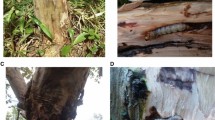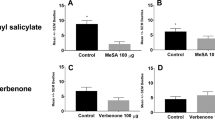Abstract
The floating fern Salvinia molesta D. S. Mitchell (Salviniaceae) originated in southeastern Brazil1, but since about 1930, it has been introduced into various tropical and subtropical regions where it has become as great a menace as the water hyacinth2–4. Biological control of salvinia has clear economic and environmental advantages over other methods of control, but earlier attempts either failed or achieved inconclusive results5–7. We report here successful control of the largest salvinia infestation in Australia using the beetle Cyrtobagous singularis Hustache (Curculionidae) and suggest why this beetle has potential for controlling salvinia infestations elsewhere.
This is a preview of subscription content, access via your institution
Access options
Subscribe to this journal
Receive 51 print issues and online access
$199.00 per year
only $3.90 per issue
Buy this article
- Purchase on Springer Link
- Instant access to full article PDF
Prices may be subject to local taxes which are calculated during checkout
Similar content being viewed by others
References
Forno, I. W. & Harley, K. L. S. Aquat. Bot. 6, 185–187 (1979).
Varshney, C. K. & Rzoska, J. (eds) Aquatic Weeds in South East Asia (Junk, The Hague, 1976).
Mitchell, D. S., Petr, T. & Viner, A. B. Envir. Conserv. 7, 115–122 (1980).
Thomas, K. J. Envir. Conserv. 6, 63–69 (1979).
Bennett, F. D. Proc. Summer Inst. biol. Control, University of Mississippi, 224–237 (Univ. Mississippi Press, 1974); Biological Control for Water Quality Enhancement Workshop, University of Florida, Gainesville, 28–35 (US Environmental Protection Agency, (1975).
Mitchell, D. S. & Rose, D. J. W. PANS 25, 171–177 (1979).
Kamath, M. K. Fiji Agric. J. 41, 55–72 (1979).
Mitchell, D. S. Aquatic Weeds in Australian Inland Waters (Australian Dept of the Environment, Housing & Community Development, Canberra, 1978).
Farell, T. P. Proc. 1st Conf. Coun. Aust. Weed Sci. Soc., 179–188 (Brown Prior Anderson, Burwood, Victoria, 1978); Proc. Aust. Wat. Resources Coun. Semin., Canberra, 57–71 (Dept National Development, Canberra, 1979).
Huffaker, C. B. & Messenger, P. S. Theory and Practice of Biological Control (Academic, New York, 1976).
Edwards, D. & Thomas, P. A. Proc. 2nd natn. Weeds Conf. S. Afr., Stellenbosch University, 221–237 (Balkema, Cape Town, 1977).
Author information
Authors and Affiliations
Rights and permissions
About this article
Cite this article
Room, P., Harley, K., Forno, I. et al. Successful biological control of the floating weed salvinia. Nature 294, 78–80 (1981). https://doi.org/10.1038/294078a0
Received:
Accepted:
Issue Date:
DOI: https://doi.org/10.1038/294078a0
This article is cited by
-
Environmental and human facets of the waterweed proliferation in a Vast Tropical Ramsar Wetland-Vembanad Lake System
Environmental Monitoring and Assessment (2023)
-
Copper accumulation in the aquatic fern Salvinia minima causes more severe physiological stress than zinc
BioMetals (2022)
-
Endocide-Induced Abnormal Growth Forms of Invasive Giant Salvinia (Salvinia molesta)
Scientific Reports (2018)
-
Biological control of weeds: an analysis of introductions, rates of establishment and estimates of success, worldwide
BioControl (2018)
-
Generation of highly potent organic fertilizer from pernicious aquatic weed Salvinia molesta
Environmental Science and Pollution Research (2018)
Comments
By submitting a comment you agree to abide by our Terms and Community Guidelines. If you find something abusive or that does not comply with our terms or guidelines please flag it as inappropriate.



